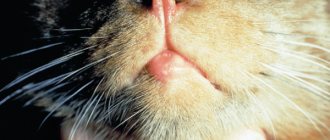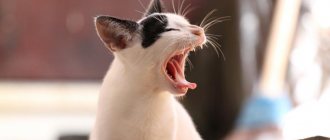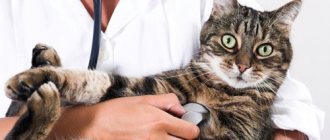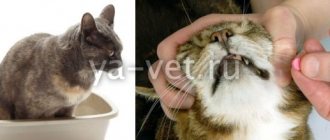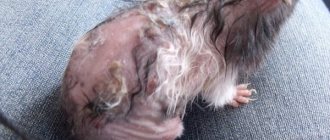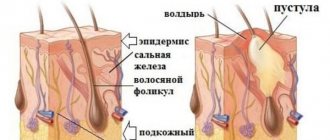Save article:
Owners of domestic cats sometimes pay attention to changes in their pet’s mood. She becomes lethargic, loses weight, and leaves unpleasant discharge behind her wherever she sits. All this speaks of developing pyometra .
This is a disease of the uterus in mostly older cats, both parous and nulliparous. This secondary infection, which occurs as a result of hormonal changes in the female genital tract, is also a type of chronic endometritis. Pyometra is characterized by a large amount of pus and mucous components accumulating in the animal’s uterine cavity, and without mandatory drug treatment and surgical intervention it leads to peritonitis, which in turn threatens the death of a beloved animal.
Caring owners should not thoughtlessly give the cat hormonal drugs, and also need to carefully monitor sanitation during childbirth and mating, and carefully monitor the health of the animal’s genitourinary system.
global $ads_google; //data-ad-slot=”2475549904″ $ads_google = empty($ads_google) ? false : true; ?> if ($ads_google == false) {?>
$ads_google = true; ?> } ?>
What is hidden under the word "pyometra"
Pyometra in a cat, or purulent endometritis, is an inflammatory process inside the uterus. Its main danger is the abundant formation of pus.
The accumulating exudate puts pressure on the internal walls and breaks them over time. Tissue damage leads to acute intoxication of adjacent parts of the abdominal cavity. The affected organs gradually lose their functionality, so the animal, left without timely help, dies.
What are the clinical signs of pyometra?
Clinical signs depend on whether the cervix remains dilated. If it is dilated, pus will flow out of the uterus through the vagina. This discharge may be observed on the skin or fur under the tail or on the bed and furniture where the cat has been lying. In many cases, it can be very difficult to see the discharge, since cats spend a lot of time on personal hygiene. A dilated cervix may (but does not necessarily) cause fever, lethargy, anorexia, and depression.
If the cervix is closed, the pus that forms inside is not able to come out. It accumulates in the uterus causing bloating. The bacteria produce toxins that are absorbed into the bloodstream. Cats with closed-type pyometra become seriously ill very quickly. They suffer from anorexia and become very lethargic and depressed. Vomiting and diarrhea may also be present.
Toxins released by bacteria affect the kidneys' ability to retain fluid. Frequent and copious urination occurs, and to compensate, the cat begins to drink a lot of water. This occurs with both open and closed pyometra.
Main causes of the disease
The main cause of pyometra in cats is a malfunction of the reproductive organs. It occurs when the following factors are present:
- False pregnancies, difficult childbirth, vaginitis, cysts and other neoplasms. In these cases, purulent endometritis is secondary and develops as a complication.
- Regular use of hormonal medications. Contraceptives used by owners to prevent unwanted pregnancy alter natural hormone levels. As a result, the cyclicity of estrus deviates from the norm, provoking inflammation and oncology.
- A sharp jump in progesterone that occurs after each ovulation. Leads to thickening of the uterine mucosa (endometrium) and a decrease in immunity. The passage of cervical mucus becomes difficult. It accumulates inside and forms pathogenic microflora.
- Bacterial infection acquired during estrus. During this period, the body is very vulnerable, so the animal may become ill due to insufficient hygiene or as a result of infection by a sick mating partner. Also, bacteria can enter the uterus not directly, but through neighboring organs: the intestines or bladder.
Most often, unsterilized animals over 5 years old become ill. The likelihood of developing pathology increases when the recommended frequency of matings is violated and during empty estrus.
If you are overweight or have a too poor diet characterized by a lack of vitamins, even a very young animal can get sick. The only way to avoid this pathology is total removal of the reproductive organs.
Diagnosis of the disease
If you suspect a pathological process in the uterus of an animal, you must immediately contact a specialist. The pet is prescribed an ultrasound, during which the doctor examines the condition of the diseased organ - as pathology develops, the size of the uterus increases significantly, its walls thicken, and cysts are visible on the surface. The animal's blood is also analyzed. With pyometra, increased urea, leukocytosis, and hyperglobulinemia are observed. Protein is found in the urine.
If the development of pyometra is suspected, the animal is subjected to ultrasound examination.
Symptoms: discharge and other signs
In cats with pyometra, pus from inside the uterus leaks out through the vulva or remains inside. In the first case, the disease is called open. This form is accompanied by the appearance of unpleasant-smelling discharge. Their color and consistency are very diverse, but always deviate from the norm.
The second form of pathology is called closed. It is much more dangerous than the first one, since at an early stage its symptoms are very difficult to detect. Changes noticeable to the owner occur much later, when the endometrial walls become very thin under the pressure of the exudate. At this point, the condition is complicated by the following symptoms:
- acute pain on palpation of the abdomen;
- convulsions and muscle spasms that impair coordination;
- false urge to urinate;
- diarrhea, vomiting and temperature fluctuations (deviation from the norm both up and down).
You should not focus only on these symptoms, as well as the flaky consistency of unusually green or gray discharge. In this case, you may simply not have time to help your pet.
It is much more reliable to start from behavioral changes that occur soon after the onset of the inflammatory process. These include unusual apathy, lethargy, poor appetite and increased thirst.
Also added to these symptoms is a gradual enlargement of the abdomen. If you are not sure about pregnancy, be sure to have your pet checked by a veterinarian.
Symptoms of pathology
Pyometra is characterized by rapid development. The first symptoms of the pathology become noticeable after about 4-6 weeks after estrus or immediately after delivery. Their nature and intensity are influenced by the form in which inflammation occurs.
When the cervix is open - the so-called open form, intense purulent discharge is observed, the cat pays great attention to the genitals, and brown spots can be seen in the places where it rests. The pet's temperature rises, she eats poorly, and drinks a lot.
The severity of the closed form of the pathology lies in the fact that pus collects in the uterine cavity. In just a few days, the volume of pus can increase greatly, which will lead to stretching of the walls of the uterus and subsequent rupture of the organ. Once in the abdominal cavity, purulent masses cause peritonitis and sepsis, which inevitably leads to the death of the animal.
With pyometra, due to accumulations of pus in the cavity and horns of the uterus, the organ significantly increases in size
For a more severe, i.e. closed, form of pathology, the following symptoms are characteristic:
- bloating and abdominal pain;
- drowsiness, low mobility and apathy;
- temperature increase;
- refusal of food;
- strong thirst;
- frequent urination.
Inflammation can also begin while the cat is pregnant. In such a situation, it is impossible to save the kittens, but there is a chance to cure the animal itself.
Danger and complications
The main danger of the disease is death from acute peritonitis. It occurs when the endometrium ruptures, causing the entire abdominal cavity to fill with pus.
Another possible complication is falling into a coma due to dehydration. In this case, the body is severely depleted, so the likelihood of recovery is minimal. Most often, the animal dies without regaining consciousness.
Carrying out diagnostics in the clinic
Diagnosis of pyometra in cats should be carried out strictly in a veterinary clinic. Otherwise, you risk damaging the endometrial walls while palpating the rounded abdomen.
Palpation alone is not enough to confirm the diagnosis. Other required studies include:
- biochemistry and general blood test;
- cytology of scrapings from the cervical canal;
- ECG, X-ray and ultrasound of the pelvis.
Based on the results obtained, not only the presence, but also the amount of exudate is determined. Based on this information, one of two methods is used to treat a mustachioed patient: medication or surgery.
Treatment of pyometra in cats
No matter how endometritis progresses in cats, the symptoms and treatment should be confirmed and carried out by a doctor. Complete recovery of the pet is possible only after surgery: removal of the uterus and ovaries.
The success of drug treatment is questionable, is allowed only in the early stages of the disease and often has relapses. As a rule, a novocaine blockade is performed in the pelvic area, a calculated amount of prostaglandin-based drugs is administered intramuscularly, followed by antibiotic therapy (gentamicin, amoxicillin for cats, intrauterine installation of tylan). In this case, prostaglandin can provoke uterine contractions up to its breakthrough and peritonitis.
Conservative treatment of cats gives the following results:
- 3 out of 4 individuals recover in the early stages of the disease, 1 out of 4 - in advanced stages;
- half of treated cats relapse after the next heat;
- 7% become infertile.
The surgical operation does not involve relapses, anesthesia and pain medication are provided for cats, complications are rare and, as a rule, due to the condition of the animal.
If necessary, intensive therapy is carried out before the intervention. Experts consider this method the most effective. Of course, you will have to forget about the offspring. However, keeping the animal alive, with a greater chance of recovery, is much more important.
Drug treatment method
In 85% of cases, medication is ineffective. For this reason, the main treatment method is surgery. It is recommended even for breeding animals, since after improvement in health there is still a high probability of relapse. In this case, kittens may be born with congenital abnormalities.
To carry out drug therapy, your pet must have a strong immune system and good health. The antibiotics and hormonal drugs used weaken the body's defenses and stimulate uterine contractions. All this is fraught with:
- miscarriages and abnormal development of fetuses;
- endometrial rupture and peritonitis;
- exacerbation of chronic pathologies;
- infertility;
- re-development of inflammation upon the onset of a new estrus or shortly after it.
It is much safer to operate on the animal immediately after diagnosis. Otherwise, the body, weakened by the disease, simply will not survive anesthesia during the next relapse, and all the efforts of the surgeon will be useless.
Prevention of pyometra
You can be sure that the cat is insured against the development of pathological processes in the uterus only if it is castrated. If the animal is used for breeding, then this measure is undesirable for the owner. Those who want to preserve the reproductive function of their pet will have to adhere to certain rules and work hard, namely:
- do not use hormonal drugs to suppress heat;
- Perform ultrasounds regularly;
- carry out matings only with carefully examined males;
- provide sterile conditions for the birth of offspring;
- take care of prompt veterinary care in case of excessively long or pathological lambing;
- Monitor discharge from the cat’s genitals and, if present, immediately contact a specialist.
Sometimes, to prevent the development of pyometra, specialists prescribe antibacterial and hormonal agents.
When surgery cannot be avoided
If a cat is diagnosed with closed pyometra, then surgery is mandatory. Other indications for emergency surgery include neoplasms and uterine rupture.
The operation involves removing not only the uterus, but also both ovaries, which completely eliminates relapses. When performing it, the laparoscopic method is increasingly used, which does not require large incisions and is limited to the application of intradermal sutures.
Carrying out the intervention
The procedure for removing reproductive organs is similar to conventional castration, but carries much more risks. This is due to purulent exudate, complicating the surgeon’s work.
If there is too much of it, the endometrium may rupture during surgery. For this reason, the animal is prescribed hormonal drugs that reduce internal pressure due to the partial removal of pus.
Other complications include internal bleeding and negative reactions to surgical sutures. In the latter case, the operation must be repeated.
You should not be afraid of the listed risks, since the consequences of the pathology itself are much more serious.
The same applies to general anesthesia. The dosage is selected individually for each patient, excluding a negative reaction to the administered drugs.
Recovery period: care and nutrition
After the pyometra is removed, a special bandage is put on the cat to protect the sutures from damage. The recovery period takes about 10-20 days, but the first improvements are noticeable already on the 2nd day. Until this point you need to:
- Maintain a fasting diet for 24 hours so as not to provoke vomiting.
- Smoothly switch to a gentle diet after the appearance of appetite. When feeding naturally, all foods should be ground or cut into small pieces. When dry feeding, wet canned food and granulated food for sterilized animals are suitable.
- Monitor the amount of fluid you consume to prevent dehydration.
- Provide a comfortable and warm place on the floor. Due to lack of coordination, jumping on high surfaces can result in injury.
Taking symptomatic medications and antibiotics is discussed individually. The same applies to seam care. Most ointments slow down tissue regeneration, so most often it is enough to prevent contamination of the postoperative wound and monitor its condition. If the stitches come apart, pus, blood or inflammation appears, it is recommended to contact a veterinary clinic.
Caring for your pet after surgery
A sick animal requires prevention of possible postoperative complications, pain reduction and additional care. In severe cases, the cat will be left in the clinic for a while. If the operation is successful and there is no threat to life, it is possible to take the animal home. At the same time, follow all the instructions of the veterinarian.
As a rule, the seam is regularly (at least once a day) treated with an antiseptic. To avoid complications, a course of antibiotics is prescribed. The cat will have to wear a blanket until it heals completely.
If organs are removed by laparoscopy, intradermal sutures are applied; special care is not required.
Even a difficult postoperative period in a cat after removal of the uterus can be alleviated by the use of special medicinal, wound healing and immunostimulating agents:
- Injectable Imunofan for cats whose price is low, but the result is proven: increasing the antiviral and antibacterial resistance of the weakened animal’s body. In the period after illness and surgery, it will have an anti-inflammatory effect and reduce possible side effects of medications. According to research, Immunofan for cats does not cause allergic reactions; you just need to take into account the required dose.
- Universal Hemobalance for cats is used for prevention and treatment, incl. and after undergoing surgical interventions. The drug will provide the sick animal with the necessary substances, restore the liver, and promote digestive and hematopoietic processes.
- Preventive Roncoleukin for cats, the price of which will not frighten even the thrifty owner, will reduce the likelihood of postoperative complications. If the condition is unstable, it will improve the pet’s condition, shorten the recovery period, and promote rapid tissue regeneration.
- A unique Traumatine for cats is recommended for all owners of tailed cats. It will help relieve pain, disinfect, and eliminate the effects of intoxication in the cat’s body. After surgery to remove the uterus, the pet will come to its senses much faster. Trauma for cats, the price of which is only about 300 rubles per bottle, will eliminate pain and the consequences of shock.
- External Aluminum spray for animals is intended for the treatment of wounds and sutures. Promotes rapid healing, has an anti-inflammatory effect. The cat is not allowed to lick the film. The duration of use after hysterectomy depends on the speed of healing and does not exceed 10 days.
- The drug ASD 2 for cats has a pronounced antiseptic effect; it should be used with caution to avoid toxic effects as prescribed by a doctor.
It should be noted that before using any drug, you should clarify the need and exact dosage with your veterinarian.
